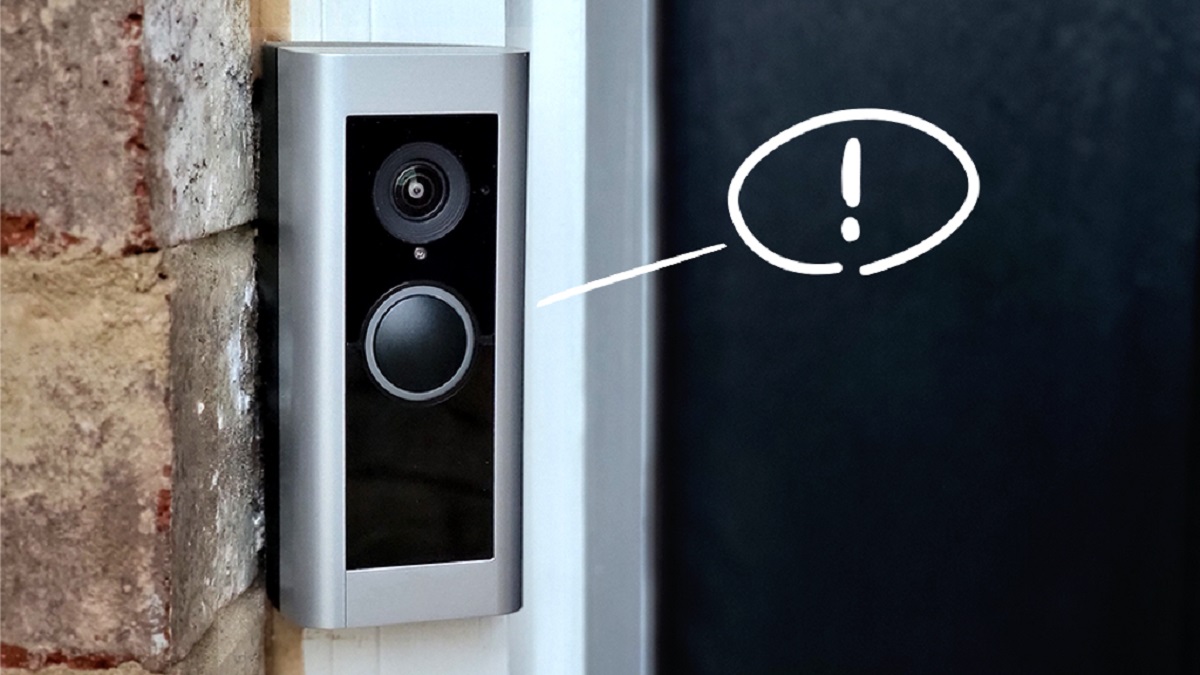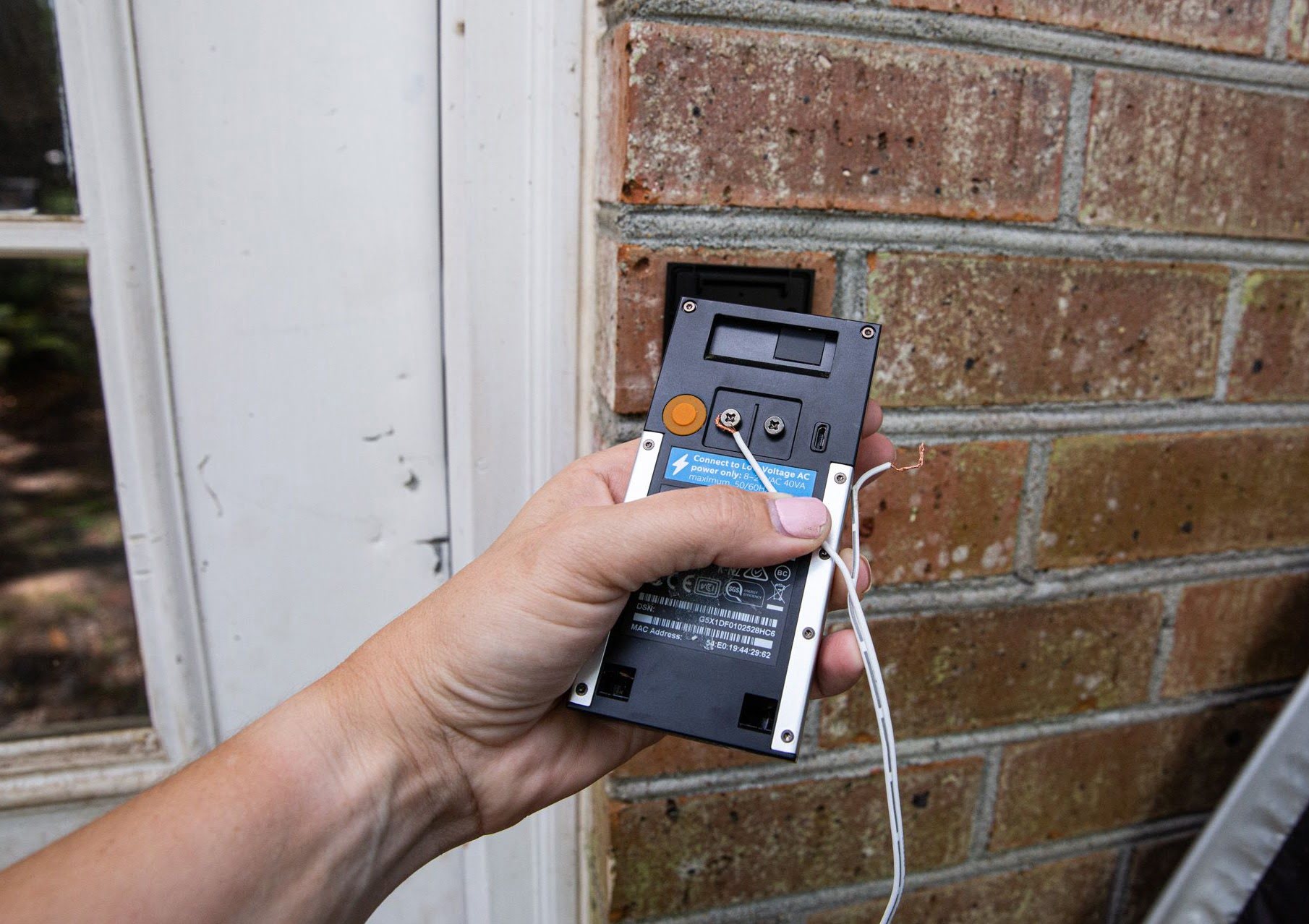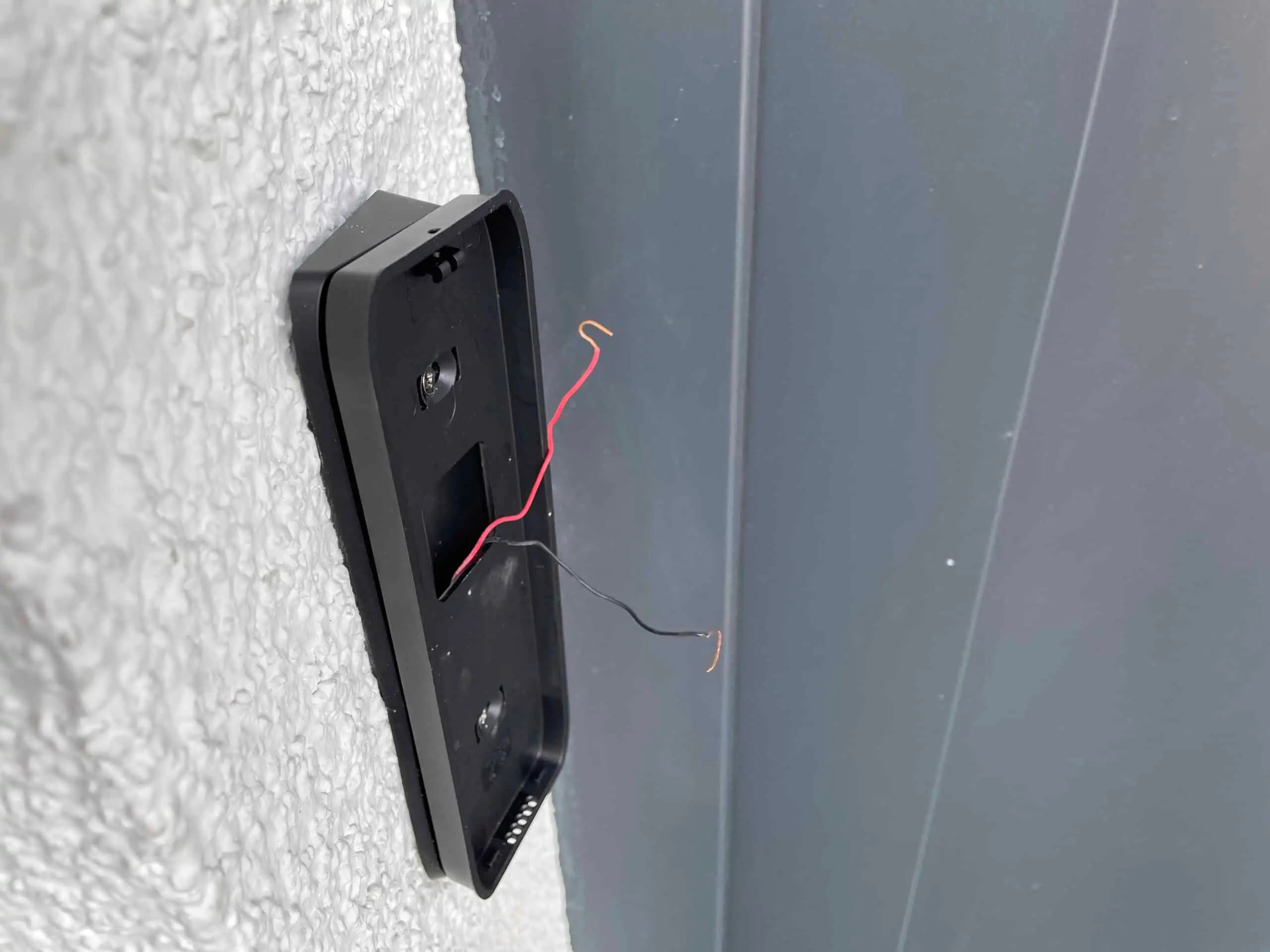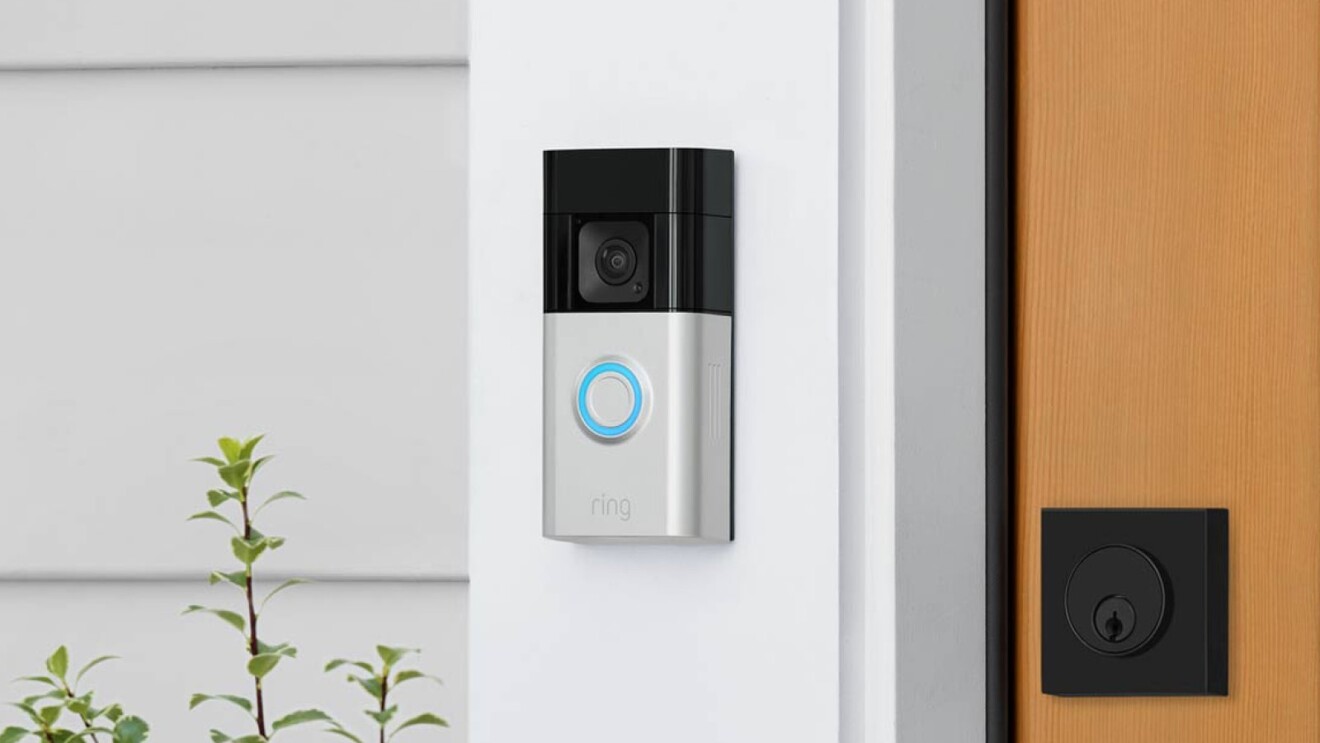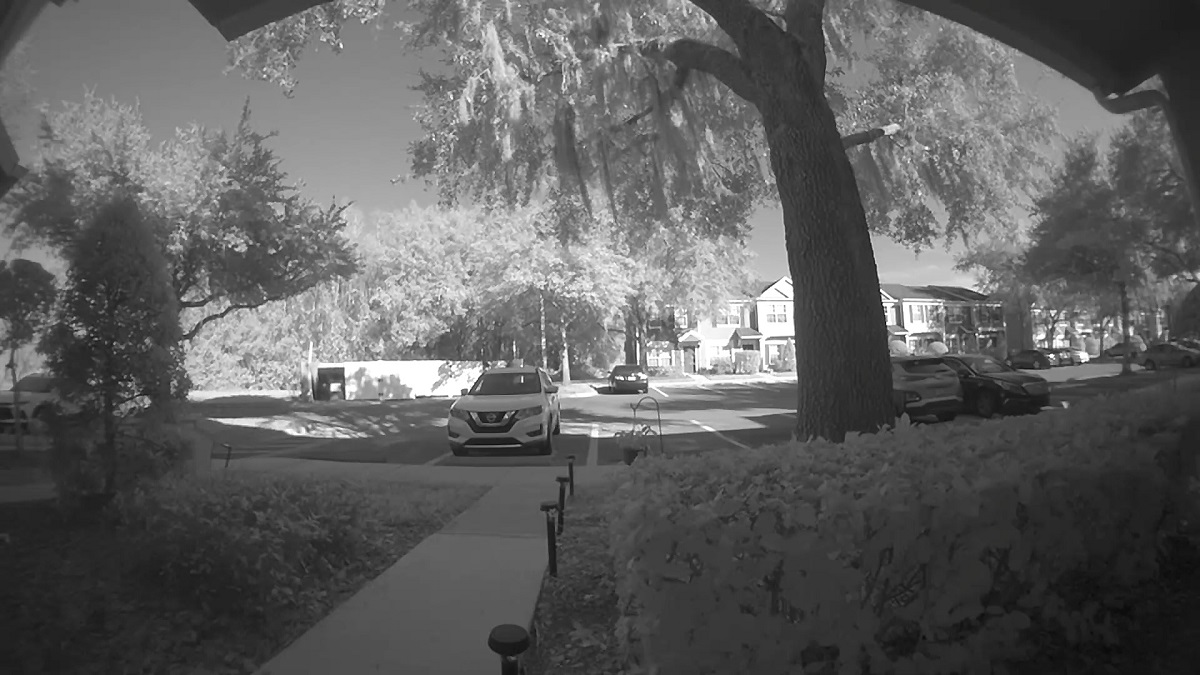Introduction
Welcome to this informative guide on the common issue of a Ring Video Doorbell not ringing your hardwired doorbell. The Ring Video Doorbell has revolutionized home security, allowing you to see, hear, and communicate with anyone at your front door, no matter where you are. However, it can be frustrating when the doorbell does not ring through your existing hardwired doorbell system.
The Ring Video Doorbell is a smart home device that replaces your traditional doorbell and connects to your home’s Wi-Fi network. It offers features such as motion detection, live video streaming, and two-way audio communication, giving you peace of mind and convenience when it comes to monitoring your home entrance.
One of the benefits of a hardwired doorbell is that it ensures a consistent power supply, eliminating the need to recharge the battery regularly. Additionally, a hardwired doorbell integrates seamlessly with your home’s existing chime, providing a familiar sound when visitors press the doorbell button.
However, there are several reasons why your Ring Video Doorbell may not ring through your hardwired doorbell system. It could be due to loose wiring, insufficient power supply, compatibility issues, or a faulty transformer. In this guide, we will explore these potential causes in detail and provide troubleshooting steps to help you resolve the issue.
By understanding the possible reasons behind the problem and following the troubleshooting steps, you can ensure that your Ring Video Doorbell rings your hardwired doorbell as intended. Let’s dive into the details and learn how to address this common issue!
Overview of the Ring Video Doorbell
The Ring Video Doorbell is a popular smart home device that has gained immense popularity in recent years. It is a wireless doorbell that comes equipped with a built-in camera, motion sensors, and two-way audio communication capabilities. The device allows homeowners to monitor their front door from anywhere using a mobile app, providing an added layer of security and convenience.
With the Ring Video Doorbell, you can see, hear, and speak to anyone at your front door, whether you are at home or miles away. When someone presses the doorbell button or triggers the motion sensors, you receive an instant alert on your smartphone or tablet, enabling you to have a real-time conversation with the visitor.
One of the key features of the Ring Video Doorbell is its high-definition camera that captures clear video footage of your front porch area. This enables you to identify who is at your door, whether it’s a delivery person, a neighbor, or an unexpected visitor. The camera also has night vision capabilities, ensuring that you have a clear view even in low-light conditions.
In addition to the video capabilities, the Ring Video Doorbell also includes two-way audio communication. This means that not only can you see and hear the person at your door, but you can also speak to them directly through the built-in speakers and microphone. This feature is particularly useful for instructing delivery drivers, communicating with guests, or deterring potential intruders.
Another benefit of the Ring Video Doorbell is its compatibility with other smart home devices. It can integrate with popular platforms such as Amazon Alexa, allowing you to use voice commands to control and access your doorbell’s features. You can ask Alexa to show you the live video feed from your doorbell on compatible devices like the Echo Show or Fire TV, enhancing the convenience and accessibility of the device.
Overall, the Ring Video Doorbell offers a range of features designed to enhance home security and provide peace of mind. Its combination of video, audio, and mobile connectivity allows you to remotely monitor and interact with visitors at your front door, making it a valuable addition to any smart home setup.
Benefits of a Hardwired Doorbell
When it comes to powering your Ring Video Doorbell, using a hardwired doorbell system offers several advantages over relying solely on the device’s battery. Let’s explore the benefits of a hardwired doorbell:
1. Consistent Power Supply: A hardwired doorbell ensures a continuous power supply to your Ring Video Doorbell. Instead of relying on battery power, which requires regular recharging or replacement, your doorbell will always be ready to function without interruption.
2. No Battery Maintenance: By connecting your Ring Video Doorbell to a hardwired system, you eliminate the need for battery maintenance. You won’t have to worry about monitoring the battery levels or experiencing downtime due to a dead battery.
3. Seamless Chime Integration: One of the key advantages of a hardwired doorbell is its compatibility with your home’s existing chime system. When someone presses the doorbell button, your existing chime will ring as it normally would, providing a familiar sound for you and your visitors.
4. Enhanced Doorbell Performance: With a hardwired connection, the Ring Video Doorbell can perform more efficiently. It can initialize faster, trigger the chime more consistently, and respond more quickly to your commands through the mobile app or other connected devices.
5. Continuous Monitoring: Unlike battery-powered doorbells that may encounter downtime during recharging, a hardwired doorbell ensures uninterrupted monitoring of your front door. This is especially important for maintaining the security and surveillance functions of your Ring Video Doorbell.
6. Integration with Existing Wiring: If you have an existing doorbell system with wiring in place, using a hardwired connection saves you the effort and cost of installing new wires. You can simply utilize the existing wiring infrastructure, making the setup process easier and more convenient.
7. Long-Term Cost Savings: While a hardwired doorbell may require professional installation, it can save you money in the long run by eliminating the need for battery replacements. You won’t have to purchase replacement batteries regularly, resulting in cost savings over the lifespan of your Ring Video Doorbell.
In summary, a hardwired doorbell offers consistent power supply, seamless integration with your existing chime, enhanced performance, continuous monitoring, and long-term cost savings. These benefits make it an ideal choice for powering your Ring Video Doorbell, ensuring optimal functionality and convenience for your home security needs.
Reasons Why Your Ring Doorbell May Not Be Ringing Your Hardwired Doorbell
If you’re facing the issue of your Ring Video Doorbell not ringing your hardwired doorbell, several reasons could be causing this problem. Let’s explore the potential causes:
1. Loose Wiring: One common reason for the doorbell not ringing could be loose or improperly connected wiring. Over time, the wiring connections can become loose, preventing the signal from reaching the doorbell chime. Checking and securing the wiring connections is a good first step in troubleshooting the issue.
2. Insufficient Power Supply: The Ring Video Doorbell requires a specific power supply to function properly. If your existing hardwired doorbell system does not supply enough power, it may not be able to ring the doorbell. Ensure that your doorbell transformer provides enough voltage and amperage for the Ring Video Doorbell’s requirements.
3. Compatibility Issues: Not all doorbell chimes are compatible with the Ring Video Doorbell. Some older or incompatible chimes may not work properly with the doorbell, causing it not to ring. Check the compatibility of your chime with the Ring Video Doorbell and consider using a compatible chime if necessary.
4. Faulty Transformer: A faulty doorbell transformer can hinder the proper functioning of your Ring Video Doorbell. If the transformer is not supplying enough power or is malfunctioning, it can prevent the doorbell from ringing. Testing your transformer or replacing it might be necessary to resolve the issue.
5. Wi-Fi Signal Interference: In some cases, Wi-Fi signal interference can disrupt the communication between your Ring Video Doorbell and your hardwired doorbell system. This can result in the doorbell not ringing. Ensure that your Wi-Fi signal is strong and consider relocating your router or using Wi-Fi extenders if needed.
6. Inadequate Doorbell Placement: Incorrect placement of the doorbell can also be a factor. Ensure that the Ring Video Doorbell is installed at the optimal height and position for proper functionality. Avoid placing it too high or in a location that obstructs the chime’s ability to ring loudly.
7. Software or Firmware Issues: Rarely, software or firmware issues with the Ring Video Doorbell itself may be the cause. Ensure that your doorbell’s software is up to date and consider restarting or resetting the device to resolve any potential software-related problems.
By considering these potential reasons and conducting the necessary troubleshooting steps, you can identify and resolve the issue of your Ring Video Doorbell not ringing your hardwired doorbell. Let’s move on to the next section to explore the troubleshooting steps in further detail.
Loose Wiring
One common cause of your Ring Video Doorbell not ringing your hardwired doorbell is loose or improperly connected wiring. Over time, the wiring connections can become loose due to vibrations or other factors, preventing the doorbell chime from receiving the necessary signal. Addressing this issue requires checking and securing the wiring connections. Here’s how:
1. Power Off: Before examining the wiring connections, ensure that the power to your doorbell system is turned off. Locate the breaker switch that controls the doorbell circuit and switch it off to avoid any electrical hazards.
2. Open the Doorbell Housing: Remove the cover of your Ring Video Doorbell to access the wiring connections. This usually involves removing a few screws or clips. Carefully lift the cover off to expose the wiring terminals.
3. Inspect the Wiring Connections: Take a close look at the wiring connections inside the doorbell housing. Check for any loose or disconnected wires. Gently tug on each wire to ensure they are securely attached to their respective terminals.
4. Tighten the Connections: If you find any loose wiring connections, tighten them using a screwdriver or pliers. Make sure the wires are properly inserted into the terminals and securely fastened. Double-check the connections to ensure they are tight and won’t come loose again.
5. Test the Doorbell: After securing the wiring connections, put the cover back on the doorbell housing and restore power to the doorbell circuit by switching the breaker back on. Test your Ring Video Doorbell by pressing the button or triggering the motion sensors to see if the doorbell chime rings as expected.
6. Seek Professional Help: If the issue persists despite securing the wiring connections, it may be advisable to consult a professional electrician or seek assistance from Ring customer support. They can provide further guidance and help resolve any underlying electrical or wiring issues.
By checking and securing the wiring connections, you can eliminate loose connections as a potential cause for your Ring Video Doorbell not ringing your hardwired doorbell. This step is often the first troubleshooting step recommended, and in many cases, it can successfully resolve the issue. If the problem persists, continue with the other troubleshooting steps detailed in this guide.
Insufficient Power Supply
Another possible reason for your Ring Video Doorbell not ringing your hardwired doorbell is an insufficient power supply. The Ring Video Doorbell requires a specific amount of power to function properly, and if your existing hardwired doorbell system does not provide enough power, it may not be able to trigger the doorbell chime. Addressing this issue requires ensuring that your doorbell system has an adequate power supply. Here’s what you can do:
1. Check Your Doorbell Transformer: Start by locating your doorbell transformer, which is usually mounted near your electrical panel or inside your attic. The transformer converts the household voltage to a lower voltage suitable for the doorbell system. Ensure that the transformer is compatible with the Ring Video Doorbell’s power requirements.
2. Verify Voltage Rating: Check the voltage rating on your doorbell transformer. The Ring Video Doorbell typically requires a voltage of 8-24 volts AC. If your transformer supplies a lower voltage, it may not provide enough power to ring the doorbell. In such cases, replacing the transformer with a compatible one may be necessary.
3. Confirm Amperage Rating: Apart from voltage, the amperage rating of the transformer is also important. The Ring Video Doorbell requires a minimum amperage of 30mA (milliamperes) to operate. If the amperage is lower, the doorbell may not receive enough power to trigger the chime. Consider upgrading the transformer if it does not meet the required amperage.
4. Consult an Electrician: If you’re unsure about the voltage or amperage rating of your doorbell transformer, or if it requires replacement or adjustment, it’s advisable to consult a professional electrician. They can assess the situation, make any necessary adjustments or installations, and ensure that your Ring Video Doorbell has an adequate power supply for proper functioning.
5. Test the Doorbell Again: After addressing any potential issues with the power supply, restore power to your doorbell system and test your Ring Video Doorbell. Press the doorbell button or trigger the motion sensors to see if the chime rings as expected. In many cases, ensuring an adequate power supply can resolve the issue.
By verifying and addressing any insufficient power supply to your Ring Video Doorbell, you increase the chances of it ringing your hardwired doorbell. It’s important to ensure that your doorbell system has the necessary voltage and amperage to power the doorbell properly. If the problem persists, continue with the other troubleshooting steps outlined in this guide.
Compatibility Issues
Compatibility issues can arise when trying to connect your Ring Video Doorbell with your existing hardwired doorbell system. Not all doorbell chimes are compatible with the Ring Video Doorbell, which can prevent the doorbell from ringing. To resolve this issue, it’s important to ensure that your doorbell chime is compatible with the Ring Video Doorbell. Here’s what you can do:
1. Check Ring’s Compatibility List: Start by consulting Ring’s compatibility list, which outlines the doorbell chimes that are known to work well with the Ring Video Doorbell. You can find this list on the Ring website or by contacting their customer support. If your current chime is not on the list, it may indicate a compatibility issue.
2. Verify Wiring Requirements: Ensure that your existing doorbell chime meets the wiring requirements specified by Ring for compatibility. It’s important to check if your chime supports the required voltage and wiring configuration for proper operation with the Ring Video Doorbell.
3. Use a Ring-Approved Chime: If your current doorbell chime is not compatible, consider using a Ring-approved chime. Ring offers a variety of chime options designed specifically for their devices, ensuring seamless compatibility and reliable operation. These chimes can be connected to your existing doorbell system for a hassle-free setup.
4. Install a Diode: In some cases, installing a diode may resolve compatibility issues between your Ring Video Doorbell and your existing chime. Ring provides instructions on how to install a diode in their support documentation. The diode helps regulate the power and voltage flow, allowing the doorbell to ring properly with the chime.
5. Seek Professional Assistance: If you’re unsure about compatibility or need assistance with the installation of a new chime or diode, consider consulting a professional electrician or reaching out to Ring’s customer support. They can provide specific guidance and recommend the most suitable options based on your doorbell system and requirements.
By ensuring compatibility between your Ring Video Doorbell and your doorbell chime, you can resolve any issues that prevent the doorbell from ringing. It’s important to verify that your chime meets the necessary requirements, and if not, consider using a Ring-approved chime or installing a diode. With the correct compatibility, you can enjoy the seamless integration of your Ring Video Doorbell into your existing hardwired doorbell system.
Faulty Transformer
A faulty doorbell transformer can be a significant cause of your Ring Video Doorbell not ringing your hardwired doorbell. The transformer is responsible for converting the household voltage to a lower voltage suitable for the doorbell system. If the transformer is faulty or not providing sufficient power, it can prevent the doorbell from ringing. Here’s what you can do to address this issue:
1. Locate the Transformer: Start by locating your doorbell transformer, which is usually mounted near your electrical panel or inside your attic. The transformer is a small rectangular or cylindrical device with wires connected to it.
2. Turn Off Power: Before inspecting or working with the transformer, turn off the power to your doorbell system. Locate the breaker switch that controls the doorbell circuit and switch it off to ensure your safety.
3. Inspect the Transformer: Once the power is off, visually inspect the transformer for any signs of damage or overheating. Look for discoloration, burnt marks, or loose connections. If you notice any significant damage or suspect a faulty transformer, it may need to be replaced.
4. Test the Voltage Output: Use a multimeter to test the voltage output of the transformer. Set the multimeter to the AC voltage range and cautiously touch the probes to the wires connected to the transformer. Ensure that the voltage output matches the requirements specified by Ring for proper operation of the doorbell.
5. Replace the Transformer: If the voltage output is lower than required or if you suspect a faulty transformer, it’s advisable to replace it. Consult a professional electrician or refer to Ring’s documentation for guidance on selecting and installing a compatible transformer.
6. Restore Power and Test: After replacing the transformer, restore power to the doorbell system by switching the breaker back on. Test your Ring Video Doorbell by pressing the doorbell button or triggering the motion sensors to see if the chime rings as expected. A new transformer should provide the necessary power to resolve the issue.
If you’re uncertain about replacing the transformer or if the issue persists despite replacing it, it’s recommended to seek assistance from a professional electrician. They can properly assess the situation and ensure that your Ring Video Doorbell has a functioning transformer for optimal performance.
Troubleshooting Steps
If your Ring Video Doorbell is not ringing your hardwired doorbell, there are several troubleshooting steps you can take to identify and resolve the issue. Following these steps can help you determine the root cause and take appropriate actions to fix the problem. Here are the troubleshooting steps:
1. Verify Wiring Connections: Check the wiring connections of your Ring Video Doorbell and ensure they are securely connected. Look for any loose or disconnected wires and reattach them if necessary. This step helps address issues stemming from loose wiring connections.
2. Check Power Supply: Verify that your Ring Video Doorbell is receiving an adequate power supply from the doorbell transformer. Ensure that the voltage and amperage requirements are met by the transformer. If not, consider upgrading or replacing the transformer to provide sufficient power.
3. Ensure Compatibility of Your Doorbell Chime: Confirm that your existing doorbell chime is compatible with the Ring Video Doorbell. Check Ring’s compatibility list and compare it with your chime model. If your chime is not compatible, consider using a Ring-approved chime that is designed to work seamlessly with their devices.
4. Test Your Transformer: Use a multimeter to check the voltage output of your doorbell transformer. Ensure that it matches the requirements specified by Ring. If the voltage output is lower or inconsistent, the transformer may need to be replaced to provide adequate power.
5. Wi-Fi Signal Check: Confirm that your Ring Video Doorbell is properly connected to your home’s Wi-Fi network. Check your Wi-Fi signal strength and consider relocating your router or using Wi-Fi extenders if the signal is weak. A strong and stable Wi-Fi connection is crucial for the proper functioning of the Ring Video Doorbell.
6. Firmware and Software Updates: Ensure that your Ring Video Doorbell has the latest firmware and software updates installed. Check the Ring app for any available updates and install them as necessary. Keeping your doorbell’s software up to date can resolve any potential software-related issues.
7. Contact Customer Support: If the troubleshooting steps above do not resolve the issue, it’s recommended to contact Ring’s customer support for further assistance. They have dedicated support teams that can provide personalized guidance and help troubleshoot specific issues with your Ring Video Doorbell.
By following these troubleshooting steps, you can systematically identify and address the underlying issue preventing your Ring Video Doorbell from ringing your hardwired doorbell. Remember to test your doorbell after each step to determine if the problem has been resolved. If necessary, seek professional assistance from an electrician or contact Ring’s customer support for further help.
Verify Wiring Connections
One of the key troubleshooting steps in resolving the issue of your Ring Video Doorbell not ringing your hardwired doorbell is to verify the wiring connections. Loose or improperly connected wiring can disrupt the signal transmission and prevent the doorbell chime from ringing. To address this issue, follow these steps to verify and secure the wiring connections:
1. Turn Off Power: Before inspecting or working with the wiring connections, ensure that the power to your doorbell system is turned off for safety. Locate the breaker switch that controls the doorbell circuit and switch it off to prevent any electrical accidents.
2. Open the Doorbell Housing: Remove the cover of your Ring Video Doorbell to access the wiring connections. This typically involves removing a few screws or clips. Carefully lift the cover off to expose the wiring terminals.
3. Inspect the Wiring Connections: Take a close look at the wiring connections inside the doorbell housing. Check each wire to ensure they are properly connected and securely attached to their respective terminals. Look for any signs of loose or disconnected wires.
4. Tighten the Connections: If you find any loose wiring connections, use a screwdriver or pliers to tighten them. Ensure that the wires are properly inserted into their respective terminals and securely fastened. Double-check each connection to ensure they are tight and won’t come loose again.
5. Test the Doorbell: After securing the wiring connections, put the cover back on the doorbell housing. Restore power to the doorbell circuit by switching the breaker back on. Test your Ring Video Doorbell by pressing the doorbell button or triggering the motion sensors to see if the doorbell chime rings as expected.
6. Seek Professional Help: If the issue persists despite securing the wiring connections, it may be advisable to consult a professional electrician or seek assistance from Ring’s customer support. They can provide further guidance and help resolve any underlying electrical or wiring issues.
By verifying and securing the wiring connections, you can eliminate loose connections as a potential cause for your Ring Video Doorbell not ringing your hardwired doorbell. This step is often the first troubleshooting step recommended, and in many cases, it can successfully resolve the issue. If the problem persists, continue with the other troubleshooting steps detailed in this guide.
Check Power Supply
Another important troubleshooting step to resolve the issue of your Ring Video Doorbell not ringing your hardwired doorbell is to check the power supply. Insufficient power can prevent the doorbell from functioning properly. To address this issue, follow these steps to ensure that your Ring Video Doorbell is receiving an adequate power supply:
1. Doorbell Transformer: Locate the doorbell transformer, which converts the household voltage to a lower voltage suitable for the doorbell system. It is usually mounted near your electrical panel or inside your attic. Ensure that the transformer is compatible with the Ring Video Doorbell’s power requirements.
2. Voltage Rating: Check the voltage rating on the doorbell transformer. The Ring Video Doorbell typically requires a voltage range of 8-24 volts AC. If your transformer provides a lower voltage, it may not deliver enough power to ring the doorbell. Consider upgrading or replacing the transformer to meet the necessary voltage requirements.
3. Amperage Rating: In addition to voltage, check the amperage rating of the transformer. The Ring Video Doorbell requires a minimum amperage of 30mA (milliamperes) to operate effectively. If the amperage is lower, it may not provide enough power for the doorbell to ring. Consider upgrading the transformer if it doesn’t meet the required amperage.
4. Professional Assistance: If you’re unsure about the voltage or amperage rating of your doorbell transformer or if it requires adjustment or replacement, it’s advisable to consult a professional electrician. They can assess the situation, make any necessary adjustments or installations, and ensure that your Ring Video Doorbell has an adequate power supply.
5. Test the Doorbell: After ensuring an adequate power supply, restore power to your doorbell system by switching the breaker back on. Test your Ring Video Doorbell by pressing the doorbell button or triggering the motion sensors to see if the doorbell chime rings as expected. Ensuring that your doorbell has the correct power supply can resolve the issue.
By checking your doorbell transformer and ensuring an adequate power supply, you increase the chances of your Ring Video Doorbell ringing your hardwired doorbell. It’s important to confirm that your transformer meets the necessary voltage and amperage requirements. If the problem persists, continue with the other troubleshooting steps outlined in this guide.
Ensure Compatibility of Your Doorbell Chime
When facing the issue of your Ring Video Doorbell not ringing your hardwired doorbell, one potential cause is a compatibility issue between your existing doorbell chime and the Ring Video Doorbell. Not all doorbell chimes are compatible with the Ring Video Doorbell, which can prevent the doorbell from ringing. To resolve this issue, it’s important to ensure compatibility between your doorbell chime and the Ring Video Doorbell. Here are the steps you can take:
1. Check Ring’s Compatibility List: Start by consulting Ring’s compatibility list, which provides information on the doorbell chimes known to work well with the Ring Video Doorbell. You can find this list on the Ring website or by reaching out to their customer support. If your existing chime is not on the list, it may indicate a compatibility issue.
2. Verify Wiring Requirements: Ensure that your current doorbell chime meets the wiring requirements specified by Ring for compatibility. Check if your chime supports the required voltage and wiring configuration necessary for proper operation with the Ring Video Doorbell.
3. Use a Ring-Approved Chime: If your existing doorbell chime is not compatible with the Ring Video Doorbell, consider using a chime that is approved by Ring. Ring offers a variety of chime options designed specifically for their devices, ensuring seamless compatibility and reliable operation. These chimes can be connected to your existing doorbell system for a hassle-free setup.
4. Install a Diode: In some cases, installing a diode may help resolve compatibility issues between your ring Video Doorbell and your doorbell chime. Ring provides instructions on how to install a diode in their support documentation. The diode helps regulate the power and voltage flow, allowing the doorbell to ring properly with the chime.
5. Seek Professional Assistance: If you’re unsure about compatibility or need assistance with the installation of a new chime or diode, consider consulting a professional electrician. They can provide specific guidance and recommend the most suitable options based on your doorbell system and compatibility requirements.
By ensuring compatibility between your doorbell chime and the Ring Video Doorbell, you can address any issues that prevent the doorbell from ringing. Verify that your chime meets the necessary wiring requirements and, if needed, consider using a Ring-approved chime or installing a diode. With the correct compatibility, you can enjoy the seamless integration of your Ring Video Doorbell into your existing hardwired doorbell system.
Test Your Transformer
Testing your doorbell transformer is an essential troubleshooting step when your Ring Video Doorbell is not ringing your hardwired doorbell. A faulty transformer can result in insufficient power supply to the doorbell, causing it to not ring properly. To determine if the transformer is the culprit, follow these steps to test it:
1. Safety Precautions: Before beginning the testing process, take the necessary safety precautions. Familiarize yourself with the electrical panel and locate the breaker switch that controls the doorbell circuit. Switch off the breaker to cut off the power supply to the doorbell.
2. Locate the Transformer: The next step is to locate the doorbell transformer. It is usually mounted near the electrical panel, in the basement, attic, or utility room. Look for a small rectangular or cylindrical device with wires connected to it.
3. Multimeter Setup: Retrieve a multimeter, set it to the AC voltage range, and ensure that the dial is set to an appropriate range for the voltage output of the transformer (e.g., 20V for a 16V transformer). Also, ensure that the probes are plugged into the appropriate ports on the multimeter.
4. Voltage Measurement: With the multimeter ready, touch the probes to the wires connected to the transformer, ensuring that one probe is touching the wire from the transformer and the other probe is touching the wire connected to the doorbell system. The multimeter will display the voltage output of the transformer.
5. Compare Results: Compare the voltage measurement on the multimeter with the voltage rating specified by Ring for the proper operation of the Ring Video Doorbell. If the measured voltage is significantly lower or inconsistent, it indicates a problem with the transformer.
6. Consult a Professional: If the voltage output is lower than the required rating or if you suspect a faulty transformer, it’s advisable to consult a professional electrician. They can assess the situation, provide guidance, and replace the transformer if necessary.
7. Restore Power and Test: After testing the transformer, restore power to the doorbell circuit by switching the breaker back on. Test your Ring Video Doorbell by pressing the doorbell button or triggering the motion sensor to see if the chime rings as expected. A functioning transformer should ensure proper power supply to the doorbell.
By testing your doorbell transformer, you can determine if it is the source of the problem. If the voltage output is inadequate, replacing the transformer is usually necessary to provide the proper power supply for your Ring Video Doorbell to ring your hardwired doorbell.
Conclusion
When your Ring Video Doorbell is not ringing your hardwired doorbell, it can be frustrating and impact the functionality of your home security system. However, by following the troubleshooting steps outlined in this guide, you can identify and resolve the underlying issues causing the problem.
From verifying wiring connections to checking the power supply, ensuring compatibility, and testing the transformer, each step plays a crucial role in diagnosing and resolving the problem. These troubleshooting steps systematically address potential causes such as loose wiring, insufficient power supply, compatibility issues, and faulty transformers.
Remember, it is important to follow safety precautions and seek professional assistance if you are unsure or uncomfortable with any step, especially when dealing with electrical components. Electricians and Ring’s customer support team are there to provide expert guidance and assistance in resolving complex issues or performing installations.
With the proper troubleshooting steps, you can restore the functionality of your Ring Video Doorbell and ensure that it rings your hardwired doorbell as intended. Enjoy the convenience and security of your fully functioning home doorbell system.







